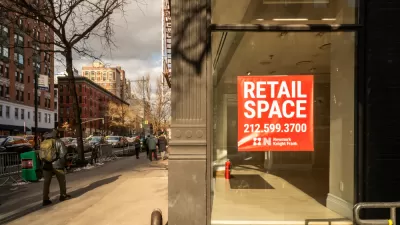Across racial and economic lines, not all cities are recovering equally.

Kenrya Rankin shares news of a new study from the Urban Institute that ranks city on the inclusiveness of economic recovery since the Great Recession.
The "Inclusive Recovery in the United States" [pdf] report created indices for the 274 most populated cities in the United States, tracking inclusivity at intervals, i.e., 1980, 1990, 2000, and 2013. According to the definition included in the report, "inclusive recovery occurs when a place overcomes economic distress in a way that provides the opportunity for all residents—especially historically excluded populations—to benefit from and contribute to economic prosperity. In short, the recovery must embody both economic and racial inclusion to be equitable."
All five of the most inclusive recoveries were located in California: Fremont, Daly City, Torrance, Santa Clara, and Elk Grove. At the other end of the spectrum, Dallas' recovery has been the least inclusive, followed by Shreveport, Houston, South Bend, and Phoenix.
For more insight into the report, see also a blog post written by several of the authors of the report. That post provides five bog takeaways from the report, including insight into what makes inclusive cities inclusive.
FULL STORY: STUDY: The Most—and Least—Inclusive Cities in the Nation

Planetizen Federal Action Tracker
A weekly monitor of how Trump’s orders and actions are impacting planners and planning in America.

San Francisco's School District Spent $105M To Build Affordable Housing for Teachers — And That's Just the Beginning
SFUSD joins a growing list of school districts using their land holdings to address housing affordability challenges faced by their own employees.

The Tiny, Adorable $7,000 Car Turning Japan Onto EVs
The single seat Mibot charges from a regular plug as quickly as an iPad, and is about half the price of an average EV.

Seattle's Plan for Adopting Driverless Cars
Equity, safety, accessibility and affordability are front of mind as the city prepares for robotaxis and other autonomous vehicles.

As Trump Phases Out FEMA, Is It Time to Flee the Floodplains?
With less federal funding available for disaster relief efforts, the need to relocate at-risk communities is more urgent than ever.

With Protected Lanes, 460% More People Commute by Bike
For those needing more ammo, more data proving what we already knew is here.
Urban Design for Planners 1: Software Tools
This six-course series explores essential urban design concepts using open source software and equips planners with the tools they need to participate fully in the urban design process.
Planning for Universal Design
Learn the tools for implementing Universal Design in planning regulations.
Smith Gee Studio
City of Charlotte
City of Camden Redevelopment Agency
City of Astoria
Transportation Research & Education Center (TREC) at Portland State University
US High Speed Rail Association
City of Camden Redevelopment Agency
Municipality of Princeton (NJ)




























